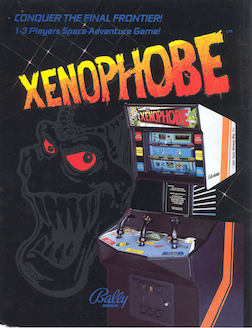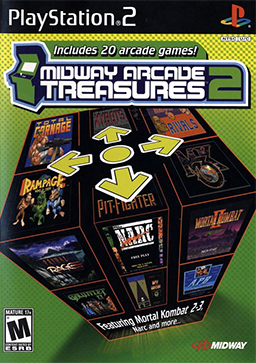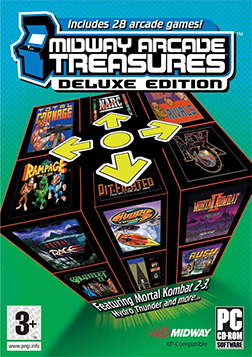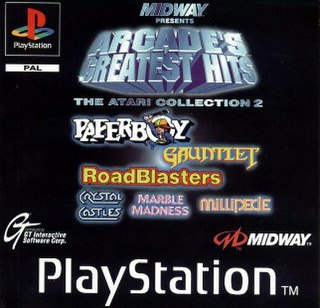
Marble Madness is an arcade video game designed by Mark Cerny and published by Atari Games in 1984. It is a platform game in which the player must guide a marble through six courses, populated with obstacles and enemies, within a time limit. The player controls the marble by using a trackball. Marble Madness is known for using innovative game technologies: it was Atari's first to use the Atari System 1 hardware, the first to be programmed in the C programming language, and one of the first to use true stereo sound.

Xenophobe is a video game developed by Bally Midway and released in arcades in 1987. Starbases, moons, ships, and space cities are infested with aliens, and the players have to kill the aliens before each is completely overrun. The screen is split into three horizontally-scrolling windows, one for each of up to three players, yet all players are in the same game world.

Joust is an action game developed by Williams Electronics and released in arcades in 1982. While not the first two-player cooperative video game, Joust's success and polished implementation popularized the concept. Players assume the role of knights armed with lances and mounted on large birds, who must fly around the screen and defeat enemy knights riding buzzards.
Midway Games Inc., known previously as Midway Manufacturing and Bally Midway, and commonly known as simply Midway, was an American video game developer and publisher. Midway's franchises included Mortal Kombat, Rampage, Spy Hunter, NBA Jam, Cruis'n, and NFL Blitz. Midway also acquired the rights to video games that were originally developed by Williams Electronics and Atari Games, such as Defender, Joust, Robotron: 2084, Gauntlet, and the Rush series.

Paperboy is an arcade action game developed and published by Atari Games, and released in 1985. The player takes the role of a paperboy who delivers a fictional newspaper called The Daily Sun along a street on his bicycle. The arcade version of the game featured bike handlebars as the controller.

Mortal Kombat 3 is a 1995 arcade fighting game developed by Midway Games. It is the third main installment in the Mortal Kombat franchise and a sequel to 1993's Mortal Kombat II. As in the previous games, it has a cast of characters that players choose from and guide through a series of battles against other opponents. The game avoids the tournament storyline of its predecessors, as various warriors instead fight against the returning Shao Kahn, who has resurrected his bride Sindel and started an invasion of Earthrealm.

Mortal Kombat II is a fighting game originally produced by Midway for the arcades in 1993. It was ported to multiple home systems, including MS-DOS, Amiga, Game Boy, Game Gear, Sega Genesis, 32X, Sega Saturn, Super Nintendo Entertainment System, and PlayStation only in Japan, mostly in licensed versions developed by Probe Software and Sculptured Software and published by Acclaim Entertainment.
The following article is a broad timeline of arcade video games.

Midway Arcade Treasures 2 is the second collection of classic arcade games published by Midway for the PlayStation 2, Xbox, and GameCube. This compilation includes 20 games that were not in the 2003 release of Midway Arcade Treasures. Unlike the previous game, it was rated M for Mature instead of T for Teen by the ESRB.

Midway Arcade Treasures is a video-game compilation of 24 arcade games, emulated from the original PCBs. The overall release was developed by Digital Eclipse and issued by Midway for the PlayStation 2, Xbox, GameCube, and Microsoft Windows.
Sinistar is a 1983 multidirectional shooter arcade game developed and manufactured by Williams Electronics. It was created by Sam Dicker, Jack Haeger, Noah Falstein, RJ Mical, Python Anghelo, and Richard Witt. Players control a space pilot who battles the eponymous Sinistar, a giant, anthropomorphic spacecraft. The game is known for its use of digitized speech and high difficulty level.

Ultimate Mortal Kombat 3 is a fighting game in the Mortal Kombat series, developed and released by Midway to arcades in 1995. It is a standalone update of 1995's earlier Mortal Kombat 3 with an altered gameplay system, additional characters like the returning favorites Reptile, Kitana, Jade and Scorpion who were missing from Mortal Kombat 3, and some new features.

Wizard of Wor is an arcade video game released in 1981 by Midway. Up to two players fight together in a series of monster-infested mazes, clearing each maze by shooting the creatures. The game was ported to the Atari 8-bit family, Commodore 64(programmed by Jeff Bruette), Atari 2600, and Atari 5200 and renamed to The Incredible Wizard for the Bally Astrocade. The original cartridge came with a cash prize offer to the first person to complete the game.

Midway Arcade Treasures Deluxe Edition is an arcade compilation released exclusively for Microsoft Windows on February 15, 2006 in North America, and on March 17 in PAL regions. It is a compilation of Midway Arcade Treasures 2 and Midway Arcade Treasures 3, which had both been previously released on consoles only. Unlike the previous two volumes, it includes the original Mortal Kombat. In the two months after its release, two official patches were released for the collection, one to fix missing music for half of the games that was accidentally left out of the shipped version, and a second one to correct a button function oversight that prevented Random Select and Smoke battle easter eggs in Mortal Kombat II. A few pieces of additional artwork for Wizard of Wor and Primal Rage were made available as supplements on the Midway website. Like the previous release, the Deluxe Edition's Primal Rage content suffered from emulation issues.

Xybots is a 1987 third-person shooter arcade game by Atari Games. In Xybots, up to two players control "Major Rock Hardy" and "Captain Ace Gunn", who must travel through a 3D maze and fight against a series of robots known as the Xybots whose mission is to destroy all mankind. The game features a split screen display showing the gameplay on the bottom half of the screen and information on player status and the current level on the top half. Designed by Ed Logg, it was originally conceived as a sequel to his previous title, Gauntlet. The game was well received, with reviewers lauding the game's various features, particularly the cooperative multiplayer aspect. Despite this, it was met with limited financial success, which has been attributed to its unique control scheme that involves rotating the joystick to turn the player character.

Midway's Greatest Arcade Hits is an arcade game compilation released for the Dreamcast, Nintendo 64, and Game Boy Advance.

Arcade's Greatest Hits: The Atari Collection 2 is a 1998 compilation of six arcade games for the Sony PlayStation and Microsoft Windows. Crystal Castles and Millipede were licensed from Atari Corporation while the others were owned by the Midway-owned Atari Games. The compilation contains artwork and info on each game, and all games are presented in their original format.

Mortal Kombat is a 1992 fighting game developed and published by Midway. It is the first entry in the Mortal Kombat series and was subsequently released by Acclaim Entertainment for nearly every home platform at that time. The game focuses on several characters of various intentions who enter a martial arts tournament with worldly consequences. It introduced many key aspects of the Mortal Kombat series, including the unique five-button control scheme and gory finishing moves called Fatalities.

Midway Arcade Origins is an arcade compilation released on November 6, 2012, in North America and in Australia. It is the successor to the Midway Arcade Treasures series, and includes a selection of games that were included in those compilations, with the sole exception of Vindicators Part II. Midway Arcade Origins was added to the Xbox One via the backwards compatibility program.














